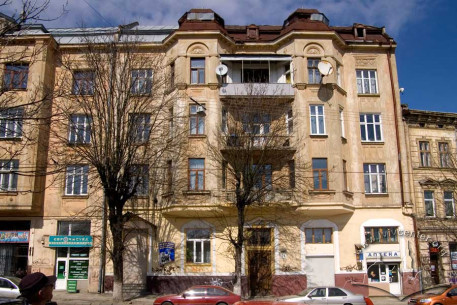Vul. Shevchenka, 24 – residential building ID: 2225
The building on Shevchenka street 24, constructed under a Michał Ulam’s project in 1913, is one of the best examples of the late Secession style architecture in Lviv. According to the resolution of the Regional Executive Committee of the Lviv Region no. 381 dated 5 July 1985, the building was entered in the local register of architectural and urban planning monuments under protection number 392.
Story
1882 – a small single-storied house, a woodshed and a barn are constructed on the plot.1913 – a residential building with a shop and a warehouse on the ground floor is constructed.
1950s – a mezzanine is arranged in the ground floor premises to the right of the entrance and a new entrance is made on the left; a concrete terrace balcony is arranged in the end western wall which can be entered from the attic apartment.
The house no. 24 on Shevchenka (earlier Yanivska or, in Polish spelling, Janowska) street is situated on the former Yanivska road, one of the busiest routes of Lviv. The plot, where the house was constructed eventually, was designated on the 1849 cadastral map of Lviv under building no. 3890 as a garden plot which was not built up. In 1881 a parcel to be built up was allocated within this garden plot.
The house no. 24 on Shevchenka street was for the first time mentioned in 1882. An estate owned by Luka Matiyashevsky was situated there at that time, with a small single-storied house, a wooden woodshed and a barn in the yard. In 1911 this parcel and a neighbouring one (building no. 26) were purchased by Michał Auerbach on behalf of the Commercial Union (Unia Handlowa). In the early 1912 the Commercial Union commissioned the Michał Ulam’s architectural bureau to design a building construction project. In June of the same year the project was approved by the Magistrate’s Building Administration, and in August of 1913 the building was constructed and put into use. According to the project, the ground floor was occupied by a shop with a warehouse (on the right) and by the Commercial Union director’s office (on the left); these premises could be entered from the lobby. The Union’s office, which occupied four large rooms, was located in the wing. A laundry was arranged in the attic.
In the Soviet time, the ground floor premises of the former shop were adapted for the accounting department of the cafeteria no. 31 belonging to the public catering trust of the Shevchenkivsky district; for this purpose a mezzanine was arranged. The laundry in the attic was turned into an apartment. In the 1990s the ground floor premises were used by private entrepreneurs.
Architecture
The building is located in the former Krakivske suburb, to the northwest of the city’s historic center. It can be distinguished in the street’s row housing due to its architectural solution.The four-storied plastered building is constructed of brick on stone foundations and is T-shaped in plan; it has an attic and two courtyards which are oriented to the east and west and are formed due to the neighbouring buildings.
This late Secession-style building has not been modified significantly in the course of its existence. Its plan consists of a two-tract main part and an elongated wing located on the axis. The large staircase is situated in the rear tract and can be entered via an entryway facing Shevchenka street. There are three apartments on each floor. This building’s plan is different from typical residential buildings and can serve as an example of the search for new spacial solutions in the early 20th century Lviv architecture. The axial position of the wing enabled a more rational solution of the residential function and better lighting of the premises. All rooms are lighted by large windows; some of the windows are arranged in bays and lateral walls. Large balconies located on the main façade between the bays and on the west inner façade served for recreation.
The main façade has a centrally axial composition, with two bays. The façade has been given late Secession style forms linked with simplified Neoclassicist geometric and plant motifs. The main entrance is located on the central axis and is accentuated by a portal with a geometrically ornamented lunette. Two faceted bays, covered with fractured helmet-shaped roofs, are a characteristic element of the façade. Balconies between the bays have plastered brick railing with metal grating which vary from floor to floor. The façade is topped with a shaped cornice supported by cantilevers between the bays and on their slanting facets. The building’s main part has a high fractured tin roof with three lucarnes (the eastern one has been lost).
The lobby walls are decorated with panels with moulded trimming, a cornice and rosettes. The stone staircase has an artistic forged metal railing. The floor is covered with ceramic tiles. The ceilings are made of concrete.
Some original stylistic elements of the façade and of the lobby décor have survived till our days, as well as the staircase, a part of apartment doors with accessories, ceramic tiles which cover the staircase floor, a stylish front door.
The building is one of the best examples of the late Secession-style architecture in Lviv.
People
Luka Matiyashevsky – an owner of the plot and a house on it.Michał Auerbach – a representative of the Commercial Union.
Michał Ulam – an architect who owned an architectural bureau.
Sources
- State Archive of Lviv Oblast (DALO). Item 2/3/1133.
- Central State Historical Archive of Ukraine in Lviv (CDIAL). Item 186/8/829 (Lviv's 1849 Cadastral Plan).
- Jakub Lewicki, Między tradycją a nowoczesnością. Architektura Lwowa lat 1893–1918 (Warszawa, 2005).











